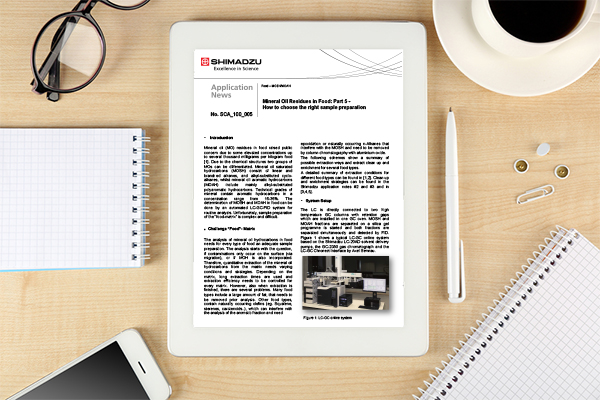Application note: Mineral oil residues in food – How to choose the right sample preparation
- Like
- Digg
- Del
- Tumblr
- VKontakte
- Buffer
- Love This
- Odnoklassniki
- Meneame
- Blogger
- Amazon
- Yahoo Mail
- Gmail
- AOL
- Newsvine
- HackerNews
- Evernote
- MySpace
- Mail.ru
- Viadeo
- Line
- Comments
- Yummly
- SMS
- Viber
- Telegram
- Subscribe
- Skype
- Facebook Messenger
- Kakao
- LiveJournal
- Yammer
- Edgar
- Fintel
- Mix
- Instapaper
- Copy Link
Posted: 3 June 2019 | Shimadzu Europa GmbH | No comments yet
The analysis of mineral oil hydrocarbons in food needs for every type of food an adequate sample preparation and this could be complex and difficult.
Mineral oil (MO) residues in food raised public concern due to some elevated concentrations up to several thousand milligrams per kilogram food [1]. Due to the chemical structures two groups of MOs can be differentiated. Mineral oil saturated hydrocarbons (MOSH) consist of linear and branched alkanes, and alkyl-substituted cyclo-alkanes, whilst mineral oil aromatic hydrocarbons (MOAH) include mainly alkyl-substituted polyaromatic hydrocarbons. Technical grades of mineral contain aromatic hydrocarbons in a concentration range from 15-35%. The determination of MOSH and MOAH in food can be done by an automated LC-GC-FID system for routine analysis. Unfortunately, sample preparation of the “food-matrix” is complex and difficult.
Challenge “Food”– Matrix
The analysis of mineral oil hydrocarbons in food needs for every type of food an adequate sample preparation. The analysis starts with the question, if contaminations only occur on the surface (via migration), or if MOH is also incorporated. Therefore, quantitative extraction of the mineral oil hydrocarbons from the matrix needs varying conditions and strategies. Depending on the matrix, long extraction times are used and extraction efficiency needs to be controlled for every matrix. However, also when extraction is finished, there are several problems. Many food types include a large amount of fat, that needs to be removed prior analysis. Other food types, contain naturally occurring olefins (eg. Squalene, sterenes, carotenoids..), which can interfere with the analysis of the aromatic fraction and need epoxidation or naturally occurring n-Alkanes that interfere with the MOSH and need to be removed by column chromatography with aluminium oxide.
Related content from this organisation
- Application Note: Measuring flavonols in tea leaves
- Application Note: Quantitative analysis of catechins in tea leaves
- Application Note: Quantitative analysis of carotenoids in tea leaves
- High-speed analysis of bitter flavours in beer
- Application Note: Determination of lactose or fructose intolerance









